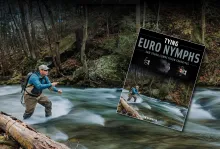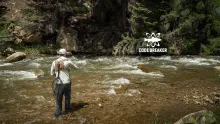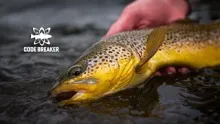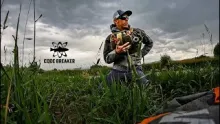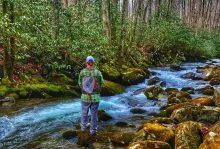A review of a nymphing book in French: Sight nymphing and trophy fish. To quote the author: "I prefer sight fishing ... It's more exciting and more effective!"
Updated or edited 2 months ago
This is the first fly fishing book written in French that has been reviewed on GFF. We have published reviews of books in Spanish, Danish, and German, but not French. And yet, the French-language bibliography is rich and the authors are truly passionate.
Jean-Claude Dufour is one of them. He is a specialist in medicine and … sight nymphing, a discipline that is gaining popularity among fly fishermen around the world. If you are one of those who subscribe to Amelia and Dave Jensen's YouTube channel, you know that they successfully practice this approach, in fact in the same way with almost the same flies pattern as Dr. Dufour.
Published in 2024 by Éditions N.C.A., "Nymphe à vue et poissons trophées" is a journey, that of the author who leads the reader through the pages in his thoughts, observations and fishing experiences to finally focus on the biggest fish of the rivers and lakes he frequents. We read this book as we read the books of the late John Gierach. The technique, the flies, everything that pushes the fisherman towards the river is first motivated by a quest, a reflection on oneself and on one's practice.
This 186-page book is divided into 16 chapters illustrated with photos of catches, nymphs, landscapes and a few illustrations. Its A4 format (29.7 cm x 21 cm) stands out in my North American library as if to remind me that it is always there, available to provide some thoughts to meditate on.
Why this book? The author has thought about it and explains that he "likes books with quality binding and paper. They embellish my library and are quickly accessible. I forget them and rediscover them". A few words later, he adds that the books that resist forgetting are those that can describe "the indescribable beauty of the world of water". The tone is set and this pragmatism will be accompanied by poetry, intelligent references and personal reflections throughout this book.
When he covers the technical elements, Dufour reminds us that sight fishing with a nymph to catch a big fish is the most exciting and effective form of fishing. It allows you to identify a specific target and choose how to reach it. He presents in sufficient detail the equipment he recommends to be successful. Then comes the chapter on tying nymphs where he describes the criteria with which he builds them to attract big trout and avoid, however little, smaller and more naive trout. As I mention later, his nymph box is filled with a few variations of the same nymphs that all have their own particularities in shape, colors, and weighting.
The chapters on approach, casting techniques, presentation, and drifting will be appreciated since they answer the questions that a beginner asks when he approaches this discipline. They present what you need to know to do it well, no more, no less. No need to dwell on these questions, the author's recommendations are simple, clear, and practical.
Where you will have to concentrate is in chapter 6 when he delivers several observations on animal ethology applied to the behavior of fish…and the prey they consume. It makes sense you will say!
The next chapter delves into his nymph box and their tying. Do not expect to see here dozens and dozens of different nymph patterns. No, you will only see the ones he uses and less than ten descriptions how to tie them. You will have understood, in the previous pages of this chapter that he is not a fan of large inventories of models but prefers a few models of nymphs mounted in different sizes and weights. Once again, simplicity and efficiency are the keys here.
The chapter Ethics, Environment, Management will make you think, it is guaranteed. I really liked the texts on combat and release, two topics on the agenda of conversations of fly fishermen in my country concerned about the survival of salmonid species, particularly anadromous species.
And then, there are all these chapters and sections where he delivers a multitude of very interesting information on what we all experience when fishing, ranging from mental and emotional balance, the photo of a catch, other species of fish to consider, fishing in lakes, etc.
In short, 186 pages of reflections, observation, adaptation, techniques, tested and experienced know-how, knowledge acquired over time and passion. Reading his work, I understood why he is known at home as one of the best sight nymph fishermen, he is so meticulous in the exercise of his art.
Note: this book is published in French only and does not exist in digital version.
- Log in to post comments

